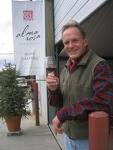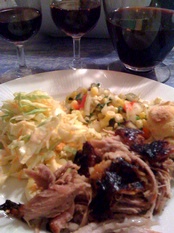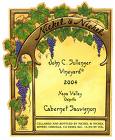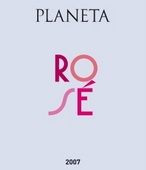|
|
 |
|
August 27, 2008
For more than 30 years Richard Sanford had been the prophet of the Santa Ynez Valley, holding forth at his iconic Sanford Winery before its sale to Tony Terlato a few years ago.
Sanford had settled in a part of the valley -- west of Highway 101 on a road that is a veritable wind tunnel from the Pacific Ocean -- that was hospitable to Pinot Noir, his passion long before the movie "Sideways."
 He's still there, in a relatively new appellation that is now called the Sta. Rita Hills. His equally new winery (founded in 2005) is Alma Rosa, and these are some of the most interesting wines in the region. This is the subject of my Creators Syndicate column this week. Click here for access. He's still there, in a relatively new appellation that is now called the Sta. Rita Hills. His equally new winery (founded in 2005) is Alma Rosa, and these are some of the most interesting wines in the region. This is the subject of my Creators Syndicate column this week. Click here for access.
What makes the Alma Rosa wines interesting and unusual is their structure. Unlike many California wineries that strive for ripeness to the point that they end up with fruit jam, Alma Rosa wines have a European sensibility that is unique in this part of the world.
The wines, especially the whites, are as much about minerals and bracing acidity as they are about fruit aromas and flavors. That said, they strike a nice balance between the two. The six new releases I tasted recently lack neither ripeness nor flavor.
They will be high acid for some wine enthusiasts, but hardly thin or green. If you are one of those who prizes wine that is alive with fresh acidity, you will find the Alma Rosa wines magnificent.
And you will be most pleased that Richard Sanford didn't simply retire to a life of leisure following the sale of the winery that bears his name.
Posted by Robert Whitley at 10:36 AM
|
|
August 26, 2008
 When Steve MacRostie released his first wine -- a 1987 Carneros Chardonnay -- there was little doubt this was a Chardonnay world. He couldn't make enough of it fast enough to keep up. When Steve MacRostie released his first wine -- a 1987 Carneros Chardonnay -- there was little doubt this was a Chardonnay world. He couldn't make enough of it fast enough to keep up.
Too much of a good thing, however, has altered the landscape for the California vintner.
"Chardonnay is very competitive," MacRostie opined over lunch this week. "The competition isn't so much from other grape varieties, though there certainly are those. There are just lots and lots of producers making Chardonnay."
Through the years MacRostie has diversified into other grape varieties, notably Pinot Noir, but also Merlot and Syrah. What hasn't changed, however, throughout the evolution of the MacRostie winery is the commitment to balance. Or, as MacRostie told me, "wine that tastes like wine."
Of course, this has been my mantra for some time now. Wines that are overripe and jammy, and too high in alcohol, generally don't appeal to me. There are a few exceptions, but they are few and far between.
When I come across a producer with a healthy respect for the grape variety and the terroir -- understanding that overripe grapes rob wine of its freshness and individual characteristics -- I stand up and take notice.
 The MacRostie Chardonnays have always done this. From my earliest experiences with MacRostie wines I've been impressed by the structure and balance of the Chardonnay. The MacRostie Chardonnays have always done this. From my earliest experiences with MacRostie wines I've been impressed by the structure and balance of the Chardonnay.
"It's always been regarded as an elegant Chardonnay," MacRostie said. "Fruit forward. We do use French barrels, but only 20 percent new. We strive for a Chardonnay that expresses typicity. It hasn't lost its Carneros-ness. It's supple. Not alcolholic or too buttery. Dry without being too austere."
Indeed, both MacRostie Chards -- I tasted the 2006 Carneros ($23) and the 2006 Wildcat Mountain Vineyard ($40) from the Sonoma Coast -- have the firm, mouth-watering acidity and a beam of fresh lemon flavor that has been a characteristic of MacRostie Chardonnay from the start.
MacRostie has carried the same philosophy into his Pinot Noir production, eschewing the current fad of making fat, sweet, jammy Pinots that will rack up big scores with certain wine publications. Both the Carneros (the 2006, $30, is now available) and the Wildcat Mountain Vineyard (2005, $45) are beautifully balanced, with plenty of grip on the back end.
Finally there are the Syrah and Merlot, reds that MacRostie has some misgivings about despite the fact both are lovely wines.
"We have stuck with Merlot against the advice of others," he said. "We've focused our efforts there on making a better wine."
 I tasted the 2005 MacRostie Napa Valley Merlot and concluded it belonged in the same group of "value" Merlots from Napa that I touted in a recent column. At $28 this is one of the finest, most satisfying Napa Valley reds to be found (the other Merlots I recommended were Chappellet, Clos du Val and Truchard). I tasted the 2005 MacRostie Napa Valley Merlot and concluded it belonged in the same group of "value" Merlots from Napa that I touted in a recent column. At $28 this is one of the finest, most satisfying Napa Valley reds to be found (the other Merlots I recommended were Chappellet, Clos du Val and Truchard).
The popularity of Merlot took a hit in the movie "Sideways" from which it still hasn't recovered. Syrah, on the other hand, simply hasn't captured the public imagination the way everyone thought it might.
MacRostie's Wildcat Mountain Syrah ($34) is stylish, with a fair amount of richness and complexity, and good length. Again, in the same vein as the other MacRostie wines, it refuses to hit you over the head with high alcohol or ripe, jammy fruit flavor.
I walked away from the tasting satisfied that I had found yet another California producer intent upon making wines that deliver nuance and finesse. Wines that are fresh, made with a philosophy that is both refreshing and compelling.
Posted by Robert Whitley at 12:28 PM
|
|
August 21, 2008
This is my idea of a really pressing question. And thanks to Marguerite Thomas and Paul Lukacs, I know the answer.
If you aren't already familiar with the "Wine With" feature that Paul and Marguerite have been publishing since we launched Wine Review Online four years ago, it is high time that you became familiar with it.
There are plenty of sources out there for advice on pairing foods and wines, but none that do what 'Wine With' does: Take real foods of the sort eaten by real people; crack open a dozen different wines that are plausible partners for the food, and then examine the results with two very sharp, very experienced palates.
We post the results of their experiments here every other week, and you'll find that the descriptions are mouth-watering and that the results are often quite surprising.
But beyond merely indicating which wines worked best with the food item in question, Marguerite and Paul also recount the inner experience of tasting the wines and the dish in a way that tells you why certain wine types work well with particular foods.
If you follow their tasting trail, you'll build knowledge that will really help you make good choices off restaurant wine lists, as well as buy wines at retail stores that will make your own cooking sing….

Posted by Michael Franz at 11:03 AM
|
|
August 19, 2008
The conventional wisdom has it that more or less 90 percent of all wines are consumed within 48 hours of purchase. This has come to be the accepted theology of wine marketeers.
But I remember a time when industry alarmists warned that despite increased consumption, there were no new wine drinkers. The CW said the pool of wine drinkers had not grown; the same old customers were simply drinking more wine.
 I challenged that premise at the time because I knew from anecdotal evidence -- primarily observations gleaned while conducting wine tasting sessions at local restaurants -- that a new and eager generation of wine enthusiasts had emerged. I challenged that premise at the time because I knew from anecdotal evidence -- primarily observations gleaned while conducting wine tasting sessions at local restaurants -- that a new and eager generation of wine enthusiasts had emerged.
So today I look around and see that, in my neighborhood, businesses that provide temperature-controlled storage facilties for wine enthusiasts are thriving as never before. I scratch my head and I wonder whether we should really assume only crusty old connoisseurs are inclined to lay down ageworthy wines in a proper cellar.
I have concluded this is clearly not the case. And that the ability to age is a factor to consider when evaluating wine. Which brings me to the topic of my Creators Syndicate column this week -- Chablis.
I like to stash away exceptional white wines that have the capacity to improve with age, then come back to them after five to ten years. White Burgundy is perhaps the greatest example of a collectible white, but most of us tend to focus on the premier and grand cru wines of the Cotes de Beaune.
 Such a fixation requires deep pockets. Not so much with premier and grand cru Chablis. Yet these wines perform admirably in the cellar, although they generally lose some of the freshness that makes them so appealing when young. Such a fixation requires deep pockets. Not so much with premier and grand cru Chablis. Yet these wines perform admirably in the cellar, although they generally lose some of the freshness that makes them so appealing when young.
For many of the top Chablis, however, the transformation is nothing short of miraculous. The wines add color and weight, and profound complexities come to full flower. Yet the prices, if you buy upon release, are a fraction of their more famous cousins from the Cotes de Beaune.
This summer I've been turned on to wonderful Chablis from William Fevre, Domaine Laroche and Joseph Drouhin. These have been remarkable wines from two outstanding vintages, 2004 and 2005.
 I've also had good experiences with wines of the Cotes de Beaune from these vintages, but I confess I am more fond of the Chablis. I've also had good experiences with wines of the Cotes de Beaune from these vintages, but I confess I am more fond of the Chablis.
Because I can afford them!
Posted by Robert Whitley at 11:04 AM
|
|
August 17, 2008
A reader named Stan recently wrote with an intriguing question that I'm certain has vexed a number of our WRO regulars, who occasionally come into a rare and valuable vintage wine.
I have had in my possession a 1963 1800ml bottle of Dow's Vintage Porto for over 10 years now, and am considering selling it. What/where would you recommend that I go about doing this?
Thank you for any help you can give.
--Stan
The question is intriguing because I'm not sure there is one good answer for the owner of a single bottle of precious wine (albeit in a large format).
 There are auction companies that handle this sort of thing, and some of them even conduct business online. A Google search of wine auctions should provide a few good leads. There are auction companies that handle this sort of thing, and some of them even conduct business online. A Google search of wine auctions should provide a few good leads.
But I wonder if the value (I'm guessing it to be around $1000) would fetch the hoped-for return after auction commissions and shipping costs were backed out? I don't really know.
I know that within the state of California, where I live, once a wine has reached a certain age it can be sold privately by a collector to a wine merchant in a legal transaction. But the wine merchant will be looking for a price well below the retail value because the merchant will have to mark-up the price on the re-sale to realize a profit.
Then there is the donation route. There are numerous charity wine auctions that will accept a donation and give the owner a tax donation credit for the full retail value.
Another interesting way of disposing of a rare vintage is through a trade with a wine merchant or collector. Someone who wants the particular bottle you are offering may be willing to trade wines you would rather have -- of equal value -- and there would be no need for money to change hands.
Of course, there's the old-fashioned solution, too. Throw a party and drink it. The 1963 Dow's was a fabulous vintage, but it has peaked. Seems like a good time to haul out a big hunk of Stilton and invite a few friends over!
Posted by Robert Whitley at 11:43 AM
|
|
August 13, 2008
This week Wine Review Online offers opinions on 40 new wines . The Reviews section is for subscribers only, so sign up now to access the updated reviews (new every Wednesday) as well as the thousands of reviews in our archives. . The Reviews section is for subscribers only, so sign up now to access the updated reviews (new every Wednesday) as well as the thousands of reviews in our archives.
The cost of a subscription is less than you might think: barely more than $1 a week!
--Vasse Felix, Margaret River, Chardonnay 'Heytesbury' 2005
--Laurenz, Austria, Gruner Veltliner 'Singing' 2007
--Domaine Laroche, Chablis Premier Cru Les Vaudevey 2005
--Vincent Girardin, Rully 1er Cru Les Cloux 2005
--Terredora Dipaolo, Campania, Greco di Tufo 2007
--Terredora Dipaolo, Campania, Falanghina 2007
--Maschio dei Cavalieri, Prosecco di Valdobbiadene Prosecco NV
Matariki, Hawke's Bay 'Quintology' 2004
--Porcupine Ridge, Cape of Good Hope Sauvignon Blanc 2007
--Pietra Santa, Cienega Valley, Pinot Noir 2006
--Willowbrook, Marin County, Pinot Noir 2006
--Kuleto Estate, Napa Valley, Cabernet Sauvignon 2004
--Kuleto Estate, Napa Valley, Syrah 2005 
--Spring Mountain, Napa Valley, Cabernet Sauvignon 2004
--Robert Mondavi Winery, Napa Valley, Fumé Blanc To-Kalon Vineyard 2006
--Trefethen, Oak Knoll District, Napa Valley, Cabernet Sauvignon 2005
--Frei Brothers, Russian River Valley, Syrah 2006
--Hartley Ostini, Santa Maria Valley, Pinot Noir Julia's Vineyard 'Hitching Post' 2006
--Byron, Santa Maria Valley, Pinot Noir Julia's Vineyard 2006
--Foxen, Santa Maria Valley, Pinot Noir Julia's Vineyard 2006
--Cambria, Santa Maria Valley,Pinot Noir 'Clone 4' (Julia's Vineyard) 2006
--Lane Tanner, Santa Maria Valley (Santa Barbara County, California) Pinot Noir Julia's Vineyard 2006
--Freeman, Sonoma Coast, Pinot Noir 'Akiko's Cuvée' 2006
--Peacock Family Vineyard, Spring Mountain District, Napa Valley, Cabernet Sauvignon 2004
--Paloma, Spring Mountain District, Napa Valley, Merlot 2005
--Simi, Sonoma County, "Roseto" 2007
--Pine Ridge, Carneros, Chardonnay 'Dijon Clone' 2006
--Truchard, Carneros, Roussanne 2006
--Pietra Santa, Cienaga Valley, Pinot Grigio "Amore" 2007
--San Saba Estate, Monterey, Chardonnay 2006
--Robert Mondavi Winery, Napa Valley, Fumé Blanc 2006
--Robert Mondavi Winery, Napa Valley, Chardonnay Reserve 2006
--Trefethen, Oak Knoll District, Napa Valley, Riesling 2007
--Trefethen, Oak Knoll District, Napa Valley, Chardonnay Estate 2006
--Clayhouse Vineyard, Paso Robles, Sauvignon Blanc 2007
--Epiphany Cellars, Santa Barbara County, Grenache Blanc Camp Four Vineyard 2007
--Kenwood, Sonoma County, Chardonnay 2006
--Long Shadows, Columbia Valley, Riesling 'Poet's Leap' 2007
Posted by Michael Franz at 10:28 AM
|
|
August 6, 2008
This week Wine Review Online offers opinions on 40 new wines. The Reviews section is for subscribers only, so sign up now to access the updated reviews (new every Wednesday) as well as the thousands of reviews in our archives.
The cost of a subscription is less than you might think: barely more than $1 a week! Click here for full Reviews.
The August 6-12 lineup:
 Ambullneo Vineyards 2006 Chardonnay, Solomon Hills Vineyard, Santa Maria Valley Ambullneo Vineyards 2006 Chardonnay, Solomon Hills Vineyard, Santa Maria Valley
Beckmen 2005 Syrah, Estate, Santa Ynez Valley
Beckmen 2006 'Cuvee le Bec', Santa Ynez Valley
Bennett Family 2005 Cabernet Sauvignon Reserve, Napa Valley
Cave Spring 2006 Riesling, Cave Spring Vineyard, Niagra Peninsula, Canada
Cave Spring 2006 Riesling, Beamsville Bench Vineyard, Niagra Peninsula, Canada
Cave Spring 2006 Riesling, Niagra Peninsula, Canada
Dry Creek Vineyard 2005 Merlot, Dry Creek Valley
Dry Creek Vineyard 2005 Cabernet Sauvignon, Dry Creek Valley
Ehlers Estate 2005 Cabernet Sauvignon '1886', St. Helena
Ehlers Estate 2005 Cabernet Sauvignon, St. Helena
Ehlers Estate 2005 Merlot, St. Helena
Flora Springs 2005 Trilogy, Napa Valley
Flora Springs 2005 Cabernet Sauvignon 'Wild Boar', Napa Valley
Flora Springs 2005 Cabernet Sauvignon, Napa Valley
Flora Springs 2006 'Soliloquy', Napa Valley
Franciscan 2004 Cabernet Sauvignon, Napa Valley
Golden Eye 2005 Pinot Noir, Gowan Creek Vineyard, Anderson Valley
Golden Eye 2005 Pinot Noir, Confluence Vineyard, Anderson Valley
Golden Eye 2005 Pinot Noir, Anderson Valley
 Lake Sonoma 2007 Chardonnay, Russian River Valley Lake Sonoma 2007 Chardonnay, Russian River Valley
Lake Sonoma 2007 Pinot Gris, Russian River Valley
Migration 2006 Pinot Noir, Anderson Valley
Nickel & Nickel 2005 Cabernet Sauvignon, John C. Sullenger Vineyard
Owl Ridge 2004 Cabernet Sauvignon, T.R. Passalacqua Vineyard, Dry Creek Valley
Owl Ridge 2004 Cabernet Sauvignon, Brigden Vineyard, Dry Creek Valley
Pago de los Capellanes 2006 Ribera del Duero 'Joven', Spain
Paul Lato 2005 'Suerte', Solomon Hills Vineyard, Santa Maria Valley
Pine Ridge 2005 Merlot 'Crimson Creek', Napa Valley
Pine Ridge 2004 Cabernet Sauvignon, Stags Leap District
Porcupine Ridge 2007 Cabernet Sauvignon, South Africa
Qupe 2005 Roussanne, Bien Nacido Hillside Estate, Santa Maria Valley
Robert Craig 2005 Cabernet Sauvignon, Howell Mountain
Robert Mondavi 2005 Cabernet Sauvignon, Oakville
Rodney Strong 2005 Cabernet Sauvignon Reserve, Alexander Valley
Steele 2004 Chardonnay, Bien Nacido Vineyard, Santa Maria Valley
Voss Vineyards 2007 Sauvignon Blanc, Rutherford Estate Vineyard, Napa Valley
Waterbrook 2007 Sauvignon Blanc, Columbia Valley
Waterbrook 2007 Riesling, Columbia Valley
Zuccadri 2007 Viognier, Mendoza, Argentina
CLICK HERE TO SUBSCRIBE TO WRO REVIEWS
Posted by Robert Whitley at 10:46 AM
|
|
August 5, 2008
 Here we are less than a month from Labor Day and I've already taken an assignment to write about holiday wines. My brain, however, is stuck on sultry. Here we are less than a month from Labor Day and I've already taken an assignment to write about holiday wines. My brain, however, is stuck on sultry.
Even if the calendar didn't remind me that summer's far from over, the thermometer would. There has been no sign that temps are about to drop. Any cool-down in the near future will have to be the product of something fresh and delicious from my trusty party tub, which I use to ice down white wines and bubbly.
And I just happen to have a few crisp whites and dry roses in mind, which is the topic of my Creators Syndicate column this week. You may read the column in a newspaper near you, or click here for online access.
One of the new releases I talk about is an exceptional 2007 Sauvignon Blanc from Windsor Sonoma. This winery was Windsor Vineyards until Pat Roney (who also owns Girard) acquired it a couple of years ago and ditched the mail-order-only business model.
 Windsor still does a bit of mail order, but the wines are now available at retail outlets nationally. Marco DiGiulio, one of the Napa Valley's top consultants, oversees the winemaking and it's easy to see his deft hand in this beautifully balanced and complex Sauvignon. Windsor still does a bit of mail order, but the wines are now available at retail outlets nationally. Marco DiGiulio, one of the Napa Valley's top consultants, oversees the winemaking and it's easy to see his deft hand in this beautifully balanced and complex Sauvignon.
I am equally high on the Planeta Rose I tasted for this column. It's a stunningly good first effort from the daring and inovative Planetas of Sicily.
Much as I love those crisp autumn nights by a crackling fire, I plan to chill and enjoy the rest of the summer.
Posted by Robert Whitley at 10:06 AM
|
|
 |
|